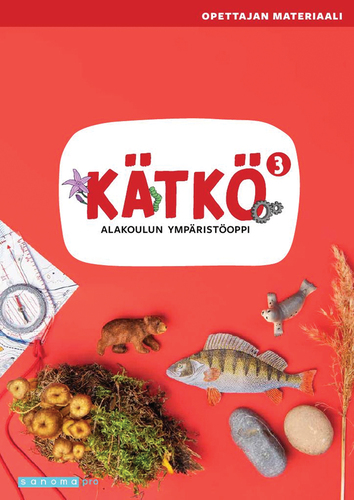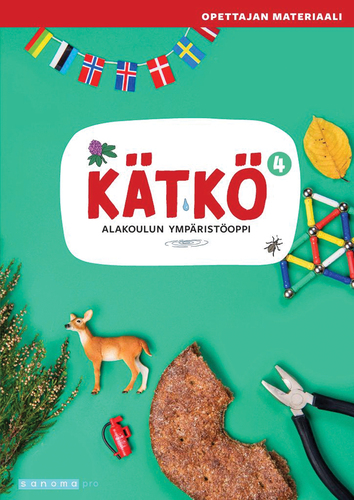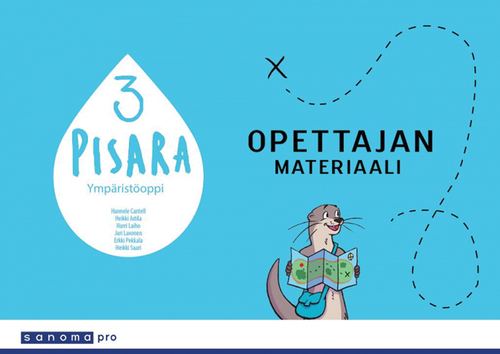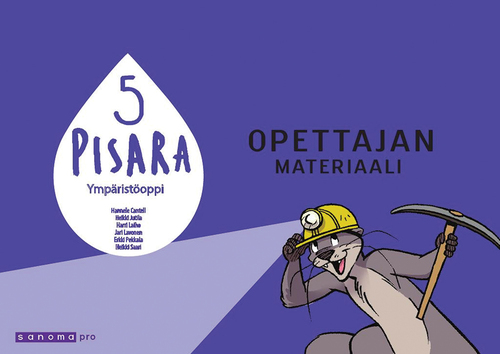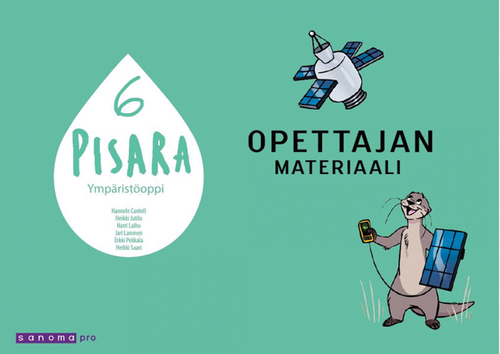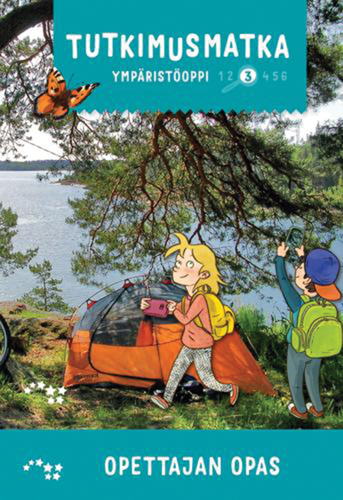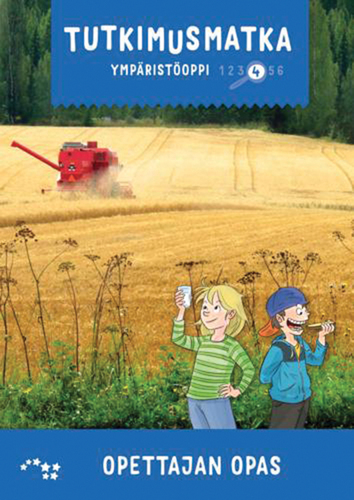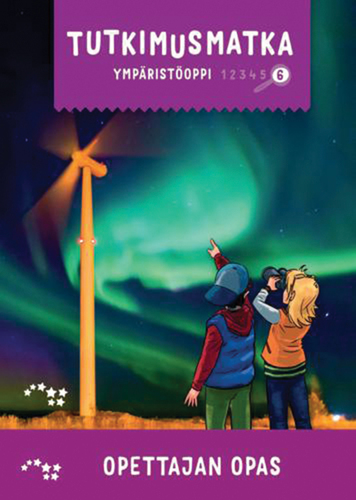Abstract
The aim of this study was to obtain knowledge on sustainability competences in the context of guidebooks for primary school teachers of environmental education. A two-step content analysis of Finnish primary-level teachers’ guidebooks in environmental studies was conducted: First, guidebooks were scanned for content related to sustainability. Second, the teaching practices associated with sustainability competences (futures thinking competence, values thinking competence, systems thinking competence, action-oriented competence, collaboration competence) were evaluated. The findings showed that guidebooks do support implementation of education for sustainable development and sustainability competences. However, some suggestions for improvement and further research ideas are presented.
1. Introduction
Sustainability competences—that is, the skills, attitudes and knowledge required to support sustainability—should be developed from early childhood to adulthood (Bianchi et al., Citation2022). All educational institutions must promote the development of these sustainability competences (UNESCO, Citation2017). Things learned in childhood are carried forward to adulthood (Chawla, Citation1998, Citation2007; Chawla & Gould, Citation2020), so it is important to study sustainability competences at the primary school level. Education for sustainable development can make lifelong changes to beliefs and attitudes, and this transfer of knowledge can be passed from children to families (Boyd, Citation2019).
Several authors have addressed and discussed the definition and use of sustainability competences in recent years. Wiek et al. (Citation2011, Citation2016) and GreenComp’s (Bianchi et al., Citation2022) definitions of sustainability competences were utilized in the present study. Wiek et al. (Citation2011, Citation2016) identified five key competences required to develop curricula for sustainability education: futures thinking competence, values thinking competence, systems thinking competence, action-oriented competence and collaboration competence. Research has shown that this definition is widely used (Redman & Wiek, Citation2021). GreenComp is a European sustainability competence framework (Bianchi et al., Citation2022) based on Wiek et al. (Citation2011, Citation2016) research, and it is relevant to all ages, so it is applicable for primary school use. GreenComp identifies four competence areas: envisioning sustainable futures, embodying sustainability values, embracing complexity in sustainability and acting for sustainability (Bianchi et al., Citation2022 p. 2).
First, futures thinking competence is the “ability to collectively analyse, evaluate, and craft rich pictures of the future related to sustainability issues” (Wiek et al., Citation2011, pp. 208–209). In GreenComp, competences futures literacy, adaptability and exploratory thinking construct an area called envisioning sustainable futures (Bianchi et al., Citation2022 p. 2). According to the results of Wiek et al. (Citation2011) systematic review, methodologies such as scenario methodology, backcasting and envisioning methods are applied in higher education to develop students’ futures thinking competence. Second, values thinking competence is the “ability to collectively map, specify, apply, reconcile, and negotiate sustainability values, principles, goals, and targets” (Wiek et al., Citation2011, p. 209). GreenComp proposes that an area called embodying sustainability values includes competences valuing sustainability, supporting fairness and promoting nature (Bianchi et al., Citation2022, p. 2). In higher education, the development of values thinking competence involves methodologies such as sustainability efficiency analysis, multicriteria assessment methods and participatory normative methods (Wiek et al., Citation2011). Third, systems thinking competence is the ability to collectively analyse complex systems across different scales (local to global) and domains (society, economy, environment, etc.) and thereby solve sustainability problems and build transition strategies toward sustainability (Wiek et al., Citation2011, Citation2016). In GreenComp an area called embracing complexity in sustainability includes the competences systems thinking, critical thinking and problem framing (Bianchi et al., Citation2022, p. 2). In higher education, methods such as qualitative and quantitative modelling, systems multimethodologies, participatory systems approaches and institutional, decision, governance and social systems analyses are used to develop systems thinking competence (Wiek et al., Citation2011). Fourth, Wiek et al. (Citation2011, p. 210) defined action-oriented competence as the “ability to collectively design and implement interventions, transitions, and transformative governance strategies toward sustainability.” According to GreenComp, an area called acting for sustainability includes competences called collective action, political agency and individual initiative (Bianchi et al., Citation2022, p. 2). Wiek et al. (Citation2011) state that planning and decision-support methodologies and methods to support behavioural change are used in higher education to develop students’ action-oriented competence. Fifth, collaboration competence is the “ability to motivate, enable, and facilitate collaborative and participatory sustainability research and problem solving” (Wiek et al., Citation2011, p. 211). Teamwork and participatory methods, including negotiation, mediation, deliberation and constructive conflict methodologies, are methods used in higher education to develop collaboration competence (Wiek et al., Citation2011).
GreenComp (Bianchi et al., Citation2022) can work as the basis of developing sustainability competences for specific education levels, like primary school, but subfields are not addressed directly in the framework. GreenComp can be used to design learning opportunities, key question being which pedagogies to use. The context and learners’ needs and backgrounds must be taken into account. Vesterinen and Ratinen’s (Citation2023) review study indicated that learning sustainability competences in primary school level “is based on children’s dialogue and collaboration with other pupils and teachers using their imaginations to achieve common environmental goals in their daily lives”. GreenComp encourages learners to reflect on and challenge personal values to support sustainability; and learning for environmental sustainability should encourage learners to take action to transform society and shape sustainable futures. “Examples of pedagogical practices that can be effective in developing the competences set out in GreenComp include: active learning; student-centred, design-based, project-based, transformative (situated) learning contexts; gamification; role plays, experimental games and simulations; analysis of real-world case studies taken from the local context; blended and online learning; project-based learning; outdoor approaches; and collaborative approaches (cooperation with external partners)” (Bianchi et al., Citation2022, p. 30).
The 2030 Agenda for Sustainable Development (UN General Assembly, Citation2015) was established to ensure that all learners achieve the skills and knowledge needed to promote sustainable development and sustainable lifestyles by the year 2030. The 17 Sustainable Development Goals balance the three dimensions of sustainable development: the social, economic and environmental. Goal 4. Ensure inclusive and equitable quality education and promote lifelong learning opportunities for all, ensures that all learners acquire the knowledge and skills needed to promote sustainable development, including, among others, through education for sustainable development and sustainable lifestyles, human rights, gender equality, promotion of a culture of peace and non-violence, global citizenship and appreciation of cultural diversity and of culture’s contribution to sustainable development by 2030 (UN, Citation2015, p. 17).
The Finnish National core curriculum for basic education (Citation2014) states that a school’s mission is to build sustainable futures for students and that students aged 9–12 (Grades 3–6) are particularly suited to considering the need for sustainable development and adopting sustainable lifestyles. According to the curriculum, students in Finland are guided to understand the importance of their own choices, lifestyles and actions not only for themselves, but also for the surrounding communities, society and nature. Personal relationship with nature helps children to understand the importance of protecting the environment. The curriculum requires that taking action for positive changes is practiced in schools. For example, the students get to know the practices of sustainable consumption.
Primary schools in Finland offer a subject called environmental studies that includes biology, geography, physics, chemistry and health education. The ecological, cultural, social and economic dimensions of sustainable development form the basis of the teaching approach for environmental studies, and the starting point is to build respect for nature and a dignified life in accordance with human rights. This subject combines both natural and human perspectives. In environmental studies, students are seen as part of the environment in which they live.
One main target in environmental studies is to support the development of the student’s environmental awareness and to guide the student to act and influence their own environment and communities to promote sustainable development (National core curriculum for basic education, Citation2014). One of the main content areas in environmental studies is called building a sustainable future. When choosing the contents, the preservation of biodiversity, climate change and its containment, sustainable use of natural resources, promotion of health, preservation of one’s own cultural heritage, living in a multicultural world and the global well-being of humanity now and in the future are taken into account.
Science teaching and learning are essential for education for sustainable development at all levels of education (Johnston, Citation2011). According to Masrifah et al. (Citation2019), teachers use books as the main sources of content for the skills and goals specified in a curriculum. Therefore, it is important that textbooks have correct content and include instructional support for teachers (Lemmer et al., Citation2008; Reys & Reys, Citation2006). The use of textbooks is more effective, when teachers’ guidebooks are available (Panezai et al., Citation2017). Chou (Citation2021) claimed that textbooks are not yet fulfilling their potential to help understand and solve global problems, and Andersen (Citation2018) found out that tasks related to sustainability topics are rare in Luxembourgish primary science text- and workbooks. According to Andersen (Citation2018), future research of school tasks for sustainability education through textbooks would be valuable in international contexts as well.
The aim of the present study was to obtain knowledge on the sustainability competences relevant to the context of primary school education. According to Vesterinen and Ratinen’s (Citation2023), sustainability competences have been studied only to a small extent at the primary school level, and the GreenComp has not yet been tested in a real setting (Bianchi et al., Citation2022), so we need information on how to teach sustainability competences at the primary school level. Notably, what science textbook authors and publishers produce directs much of what students learn (Bryce, Citation2011; Román & Busch, Citation2016). Accordingly, the research questions for the present study were as follows: How are sustainability competences presented in environmental studies guidebooks for primary school teachers? What kinds of practices are presented to foster students’ sustainability competences?
2. Methodology
Ten environmental studies guidebooks for teachers of Grades 3–6 (student age: 9–12 years) from two different Finnish publishers were selected for this study. Four of the selected guidebooks were from the publisher Otava: Tutkimusmatka 3 (2016: Figure ), Tutkimusmatka 4 (2016: Figure ), Tutkimusmatka 5 (2015: Figure ) and Tutkimusmatka 6 (2017: Figure ). Six guidebooks were from the publisher SanomaPro: Kätkö 3 (2021: Figure ), Kätkö 4 (2021: Figure ), Pisara 3 (2021: Figure ), Pisara 4 (2021: Figure ), Pisara 5 (2018: Figure ) and Pisara 6 (2018: Figure ). The photos of the covers of each book are included in this article. Otava and SanomaPro are the two biggest publishers of school material in Finland, and these books selected for this study are the most used books in environmental studies in Grades 3–6 in Finland. Schools can make a free choice about the books they use, and these are the most selected and the best known environmental studies books in Finland, so therefore these books were selected to this study. The guidebooks contain not only a textbook, but also pedagogical and didactic methods and practices for teachers to use in addition to the textbook.
A qualitative content analysis (Mayring, Citation2000, Citation2019) was the research method used in this study. Analysis of the 10 guidebooks comprises two levels: one content-related and the other learning-oriented. The content analysis involved identifying the material related to sustainability competences in the guidebooks and then assessing the pedagogies and practices associated with the identified content. When looking for content related to sustainability competences, the UN Sustainable Development Goals (SDGs; UNESCO, Citation2017) and GreenComp (Bianchi et al., Citation2022) were used as guidelines. The SDGs are global goals encouraging us all to work in collaboration to achieve sustainability by addressing challenges related to sustainable development (Bianchi et al., Citation2022).
Step 1 consisted of content-related analysis in which the books were analysed in terms of sustainability-related content. Each chapter in the books was reviewed to determine whether it connected with topics related to sustainability as defined in the UN SDGs (UNESCO, Citation2017), like health, education, equality, consumerism, climate change and environment. In this first part of analysis, a text analysis procedure was applied chapter by chapter (not page by page), and chapters which resonated with sustainability issues were selected. All the selected chapters with their contents, as well as which SDGs the chapter is about and what kind of practices were proposed to be used in teaching in that chapter, are presented in Table . Only practices proposed in these selected chapters were taken into account for the next step of analysis. A deductive category application was then developed from the base of five key sustainability competences, namely which content resonated with which sustainability competence. The guidebook content related to sustainability competences is presented in Table .
Table 1. Chapters related to sustainability in the guidebooks
Table 2. Content related to sustainability competences
Step 2 of the analysis focused on the learning-oriented level: the teaching and learning practices selected were analysed in terms of the sustainability competences, checking whether the practice allowed the develop of sustainability competences. Deductive category application was developed from the base of five key sustainability competences; in this case, which teaching practice resonated with which sustainability competence. The results of Wiek et al. (Citation2011) review, where they describe methodologies and methods used to develop students’ sustainability competences, and the results of Vesterinen and Ratinen’s (Citation2023) review, where they describe, which learning outcomes of the five key sustainability competences have been addressed in primary school settings, were utilized to link the teaching and learning practices with specific sustainability competences. The teaching practices associated with sustainability competences are presented in Table .
Table 3. Teaching practices associated with sustainability competences
3. Results
3.1. Content related to sustainability competences in teacher’s guidebooks
The contents of the guidebooks covered all 17 SDGs. The most discussed SDGs were SDG15: Life on land, SDG12: Responsible consumption and production, SDG10: Reduced inequalities and SDG13: Climate action, followed by SDG17: Partnerships for the goals, SDG3: Good health and well-being and SDG14: Life below water. The least featured SDGs were SDG2: Zero hunger, SDG5: Gender equality, SDG8: Decent work and economic growth and SDG11: Sustainable cities and communities. In this chapter, the sustainability-related contents of the guidebooks are presented in more detail, divided by five key sustainability competences.
3.2. Systems thinking competence
The findings showed that climate change is a vast topic related to sustainability in the guidebooks studied. The books focus on the causes, consequences and slowing down of climate change. Global warming is presented and the fact that fossil fuels produce carbon dioxide and, the other way round, trees clean up the air and produce oxygen. The measurements have shown that the temperatures have risen. Rising temperatures will increase storms and rain. In addition, it causes glaciers to melt and sea levels to rise. One reason for the rise in temperature is the increase in the amount of carbon dioxide in the air. More carbon dioxide is formed all the time, because more and more fuel is used in industry and transport. When driving, air pollution is created when fuel burns in the engine. Walking and cycling, on the other hand, do not cause air pollution. That is why it is good to walk and cycle whenever the journey is of a suitable length. (Cantell et al., Citation2021a, b, p. 116).
Clean environment and biodiversity are also big topics related to sustainability. The conservation and protection of nature, both on land and at sea, endangered plants and animal species and extinction are important topics. The eutrophication of lakes and seas is an important issue in the guidebooks. National parks, old forests and wastelands in cities are highlighted as important places for biodiversity.
3.3. Action-oriented competence
The guidebooks were found to convey the necessity of sustainable choices and sustainable development. The sustainable use of natural resources, such as water, energy and materials, is well emphasized in the books. Sustainable consumption and waste reduction are important topics. Product life cycle is also included. Recycling is a main topic in the books, and waste picking and sorting are mentioned too. Climate-friendly, or planetary, diets and food cultures are presented: “You should eat plenty of vegetables. Their production also produces less carbon dioxide and other climate-warming greenhouse gases than food of animal origin. That is why vegetarian food is a good option for the environment.” (Cantell et al., Citation2021a, b, p. 88).
3.4. Collaboration competence
The guidebooks were found to emphasize equality among people and teach cooperation. Globalization is discussed in the books from the viewpoint of sustainability. The topics of emigration, refugees, developing countries, poverty and colonialization are also presented, and the UN SDGs are highlighted. “Social sustainability is one of the four areas of sustainable development. Social sustainability means justice, equality, acceptance of differences and cooperation.” (Heinonen et al., Citation2015, p. 9).
3.5. Values thinking competence
Discussions about values and what a good life is, are facilitated by the guidebooks. A sustainable lifestyle is seen as a desirable way of living. New phone models are constantly coming to stores. Sometimes it can feel like your phone is ugly and old. Before you ask for a new phone, think about whether you really need it. There are many kinds of materials in the phone. Energy and materials are needed to make a phone. When you use your old and usable phone, you save nature. (Cantell et al., Citation2021a, a, p. 20.) The findings also showed that the guidebooks present ways to support mental well-being as well as reflect human rights and cultural heritage.
3.6. Futures thinking competence
Futures thinking competence was found in the contents and teaching practices of only the sixth-grade guidebooks. Many actions for a better future are outlined in the books: You are also responsible for the future of the Earth. Reduce your consumption: you save natural resources and fight climate change. Cherish nature: its preservation is also in people’s interest. Treat all people equally. Speak, discuss, write and influence. Participate in the activities of aid organizations. Donate: even a small act helps. (Arjanne et al., Citation2017, p. 160). Preparing for and adapting to changes, such as climate change, as well as critical thinking are skills that can be taught using the books. One book specifies that technological innovations can solve the world’s problems and highlights the responsible use of technology.
3.7. Teaching practices associated with sustainability competences in teacher’s guidebooks
Many practices described in this chapter can be used to develop many sustainability competences simultaneously, not just one. A method called teaching discussion, with or without images, is the most common among the teaching practices mentioned in the books, and these methods are suitable for developing all five key sustainability competences. This teaching method involves a teacher providing students with information about the topic chosen and asking questions. Presenting images and facilitating discussions about those images are teaching methods along the same lines as teaching discussion, with images being used to help understand the topic. The guidebooks include different discussion topics for the various types of competences.
The findings indicate that students’ systems thinking competence can be developed via science projects, field visits including teaching discussions and learning about cause-and-effect relationships, namely systems. Learning about cause-and effect-relationships and systems provides a foundation for developing systems thinking competence. According to the guidebooks, teaching practices suitable for developing systems thinking competence include mind maps, information searches, following news about climate or environment, reading texts from the textbook and providing independent writing tasks or tests. Topics can be, for example, the causes of climate change or “the pros and cons of plastic” (Cantell et al., Citation2018a, a, p. 234).
Students can develop their own science projects or conduct individual research to develop systems thinking competence. Illustrating the greenhouse effect using a glass jar is a suggested project. Visits to different places can be teaching opportunities if they include discussions related to sustainability. For example, everyman’s rights, which specify what you can or cannot do in nature and why, can be taught outdoors. In Norðdahl and Jóhannesson’s (Citation2016) study, teachers stated that the outdoor environment offered numerous opportunities to develop children’s views, knowledge, and action towards sustainability.
Assaraf and Orion (Citation2010) reported that systems thinking can and should be developed in elementary school, and they suggested developing students’ ability to identify (i) processes and components, (ii) the relationships between two components, and (iii) the dynamic relationships within a system, in that order. In their study, lab experiments and simulations, involving direct interactions with the components and processes of the water cycle in an outdoor learning environment and knowledge integration activities, were used to develop students’ systems thinking skills. Also Iliopoulou (Citation2018) made a research on 6-year-olds’ and 9-year-olds’ competence to think systemically, and the results revealed that teachers should encourage young students to think systematically as they are capable of doing so. Iliopoulou (Citation2018) suggests that environmental issues are taught holistically with visual, linguistic and kinesthetic methods in order to develop systems thinking competence.
The results of the present study suggest that action-oriented competence can be developed by students reflecting on their own habits, acting as change agents and taking action for sustainability. Acting sustainably is specified as the way to develop action-oriented competence. Some teaching practices presented in the guidebooks involve encouraging students to act, for example, via an advocacy project. Younger students can practice a demonstration by playing, for example: “a demonstration of soft toys for the climate: Let’s make signs, place them on soft toys and take a picture” (Cantell et al., Citation2021b, a, p. 69). Older students can organize a real demonstration and topics can be, for example, “reducing the school’s water or energy consumption or implementing a climate campaign” (Cantell et al., Citation2018b, b, p. 28). Picking up litter and recycling waste are actions suggested in almost every guidebook studied. To learn about sustainable consumption, the guidebooks suggest studying advertisements or tuning old products (Cantell et al., Citation2021b, p. 49).
Reflecting on one’s own habits was found to be a common approach to teaching sustainability in the guidebooks. Topics in this regard can be, for example, inventing ideas or making sustainable choices at home or at school. Students can also monitor their daily water consumption or biowaste generation. Calculating energy prices or carbon footprints are also suggested methods. In Levchyk et al. (Citation2021, p. 353) study, a pedagogy of empowerment called “motivation and inspiration for action” was used to develop children’s responsibility for their own behaviours and actions. This pedagogy of empowerment motivated students to work toward sustainable development and helped confirm the relationship between values and behaviour.
One approach to developing students’ action-oriented competence, as mentioned in the guidebooks, is allowing them to act as change agents for sustainability. Students can give instructions to parents, teachers or policy-makers on accounting for sustainability. The guidebooks suggest that students make posters, videos, letters to newspaper editors or tweets about themes such as slowing down climate change, protecting waters or reducing waste. Students can also write down a promise to work for the environment. In So and Chow’s (Citation2019) case study, primary school students were trained to work as green ambassadors who pass on their knowledge and experiences to their peers. Research showed that this was a good way to build an active and cooperative learning environment.
Collaboration competence can be developed by reflecting on diversity and equality and learning cooperation and negotiation skills. Teaching practices in this regard enable students to work together through drama, debate, discussion, games, pair or group work and/or meetings. The topics of the roleplay can be, for example, refugees, emotions or working together with others. For example: “Small situations with bullying and bad behaviour are presented in the group. Let’s change representations so that unwanted behaviour is corrected to kindness and consideration.” (Heinonen et al., Citation2016, p. 10). According to Bassachs et al. (Citation2020), students’ participation in cooperative modes of learning improves their social relationships with peers. Vesterinen and Ratinen (Citation2023) claimed that cooperation provides the base for gaining sustainability competences in primary school.
The results of the present study suggest that values thinking competence can be developed via dialogue and value reflection. Line of values is a teaching method that involves students choosing their place between two dimensions of a line: one end denoting agreement with a topic, and the other end denoting disagreement. This allows students to express opinions and generate conversations. Reflecting on the most important human rights and making a list of things required for a good lifestyle are also mentioned as practices for value discussions. According to Malandrakis and Chatzakis (Citation2014), developing children’s attitudes towards sustainability is necessary at the early years of schooling.
All the guidebooks studied encourage teachers to take students to nature. The goal of the nature trips is to encourage students to spend time in nature. “Fun experiences and experiences in nature motivate children to make environmentally friendly solutions in their own lives, because you care for what you love” (Arjanne et al., Citation2016, p. 180). The relationship with nature does not arise by itself, it has to be learned. That is why it is worth visiting nature often. “A strong relationship with nature is the key to adopting a sustainable lifestyle and to your own well-being” (Arjanne et al., Citation2017). Also according to GreenComp (Bianchi et al., Citation2022), a sense of being connected with nature should be a basis for our relationship with the environment. Previous studies have shown that childhood experiences in nature increase environmental sensitivity (Chawla, Citation1998).
This study also revealed that futures thinking competence can be developed by reflecting on change and envisioning methods. Imagining the future, or backcasting, is a teaching practice presented in the guidebooks studied. The guidebooks also suggest that students invent ideas to make the world a better place and determine how to achieve them. Students can also discuss the questions: “What changes have there been in your life? and Which changes have you influenced yourself?” (Cantell et al., Citation2018a, b, p. 181). In Julien et al. (Citation2018) study, futures thinking competence was developed by offering students the opportunity to project themselves into the future through drawing activities, scenarios and roleplay, and these learning tools proved effective.
4. Discussion
The focus of this study was on how sustainability competences are developed through environmental education at the primary school level. The findings of this study show that Finnish guidebooks for teaching environmental studies do support implementation of education for sustainable development and sustainability competences. It is likely that the results of this study will be useful in international contexts as well. However, books should put more emphasis on the fact that the well-being of nature is important above all for its own sake and for future generations. Humans are part of nature, and supporting fairness is about preserving nature for future generations and for nature itself (Bianchi et al., Citation2022). According to Washington (Citation2018), making education more ecocentric, and teaching in a way that encourages a sense of wonder at nature, are keys to a sustainable future.
This study suggests that in education for sustainable development at primary school, emphasis must be placed on the development of the student’s good connection with nature. Research indicates that positive experiences with nature in childhood lead to active care of the environment in adulthood (Chawla, Citation2007). “Children and adults with higher measures of nature connection report more pro-environmental behaviours of many kinds” (Chawla & Gould, Citation2020, p. 636). According to Steele et al. (Citation2016), environmental education, both indoors and outdoors, must be a part of education for all students. It has an impact on attitudes about self in the context of world, and also overall health and wellness.
This study suggests also that guidebooks could more strongly bring out community projects of denaturalization, what is called civic ecology practices. For example, Krasny and Tidball (Citation2009) found out that an environmental education program, in which learning is situated in civic ecology practices, has the potential to address both environmental and community goals. Environmental education can support youth agency and empowerment for climate action (Ruiz-Mallén et al., Citation2022). According to the results of Vesterinen and Ratinen’s (Citation2023) review, the development of sustainability competences is most effective when adults support children’s actions for sustainability. The authors also stated that in primary school, values must be discussed upon considering students’ abilities.
This study suggests that teachers offer children opportunities to reflect on their thoughts and ways of acting in order to promote sustainability. According to Cheng and So (Citation2015), a teacher with good environmental understanding can move from using textbooks to integrating environmental teaching into daily dialogues with students. Also according to Boyd’s (Citation2019) study, it is important to allow children time to reflect and to think about environmental issues, and also to offer solutions to problems. Previous studies have shown that students need a feeling they still have hope in the future left (Ojala, Citation2017; Ratinen, Citation2021). Teachers need to make students believe in their own competence and ability to meet challenges successfully (Smith et al., Citation2016). In Steele et al. (Citation2016) study, educators became provocateurs, challenging not only the thinking of their students, but also of themselves. Reflecting on sustainability topics together can be fruitful for both the teacher and the students.
All key competences need to be considered in the teaching and learning of sustainable development (Vesterinen & Ratinen, Citation2023). Still, futures thinking competence was found in the contents and teaching practices of only the sixth-grade guidebooks in the present study. However, Julien et al. (Citation2018) showed that futures thinking competence can be developed from primary school onward. Therefore, this study suggests that students’ futures thinking competence should be developed early in primary school, rather than in the sixth grade only.
Education for sustainable development must be included in all subjects, not only in environmental studies. Actually, environmental education should be integrated into the entire school life, not only into the subject curriculum (So & Chow, Citation2019). Sustainability should be the foundation for all learning (UNESCO, Citation2017). According to Brundiers et al. (Citation2010), students’ sustainability competencies develop in real-world learning situations, but not automatically. Therefore, learning situations must be well organized, and a whole-school approach—wherein a sustainability culture is established across all elements of a school—should also be considered (Bianchi et al., Citation2022).
Teachers play a major role in including these themes and practices in their teaching approaches. Teachers can make sustainability transformation happen in schools, but they need new competency to do so (Karvonen et al., Citation2023). Time and resource limitations are common challenges that teachers meet when trying to teach sustainability (Evans et al., Citation2012; So & Chow, Citation2019; Stewart et al., Citation2021). The limitation of this research is that there is no evidence that teachers completely understand the content of these guidebooks, or they have time or tools to use all of them. A shift in mindset and behaviour is required to support sustainable lifestyles (Bianchi et al., Citation2022), and a teacher can help to make this transition happen (Boyd, Citation2019). Therefore teachers need greater scientific and administrative support like teacher training to achieve this goal (Malandrakis & Chatzakis, Citation2014). In this regard, further information about what works in teaching and learning sustainability is required, so reliable assessments need to be conducted (Redman et al., Citation2021). Recommendations for future research could be for example to interview teachers to know about the use of the guidebooks.
Katko4.jpg
Download JPEG Image (549.2 KB)About the author.docx
Download MS Word (12.6 KB)Tutkimusmatka4.jpg
Download JPEG Image (47.6 KB)Tutkimusmatka3.jpg
Download JPEG Image (61.3 KB)Pisara3.jpg
Download JPEG Image (265.8 KB)Katko3.jpg
Download JPEG Image (471.1 KB)Pisara4.jpg
Download JPEG Image (309.6 KB)Pisara5.jpg
Download JPEG Image (243.4 KB)Tutkimusmatka6.jpg
Download JPEG Image (34 KB)Tutkimusmatka5.jpg
Download JPEG Image (37.6 KB)Pisara6.jpg
Download JPEG Image (219.7 KB)Disclosure statement
No potential conflict of interest was reported by the author(s).
Supplementary data
Supplemental data for this article can be accessed online at https://doi.org/10.1080/2331186X.2023.2286120
Additional information
Funding
Notes on contributors

Marjo Vesterinen
Marjo Vesterinen is a Doctoral Candidate at the Faculty of Education at the University of Lapland, Rovaniemi, Finland. This article is a second article for her dissertation about teaching and learning of sustainability competences in a primary school level. The first article, Sustainability competences in primary school education – a systematic literature review, was published on January 2023 in the journal Environmental Education Research and written with her supervisor, Professor Ilkka Ratinen, the Faculty of Education at the University of Lapland, Rovaniemi, Finland. The third article for the dissertation is now in progress. It’s a case study about teaching sustainability competences to primary school students. Marjo Vesterinen is working in a school as a sustainability teacher at the moment and collecting data for her third and last article of the dissertation.
References
- Andersen, K. N. (2018). Evaluation of school tasks in the light of sustainability education: Textbook research in science education in Luxembourgish primary schools. Environmental Education Research, 24(9), 1301–39. https://doi.org/10.1080/13504622.2017.1384798
- Arjanne, S., Heinonen, M., Jortikka, S., Kohtamäki, J., Korhonen, M., Kuusela, O., & Laine, A. 2017. Tutkimusmatka 6. Ympäristöoppi, opettajan opas. Helsinki.
- Arjanne, S., Heinonen, M., Jortikka, S., Kohtamäki, J., Korhonen, M., Kuusela, O., Laine, A., & Taimi, M. 2016. Tutkimusmatka 4. Ympäristöoppi, opettajan opas. Helsinki.
- Assaraf, O. B.-Z., & Orion, N. (2010). System thinking skills at the elementary school level. Journal of Research in Science Teaching, 47, 540–563. https://doi.org/10.1002/tea.20351
- Bassachs, M., Cañabate, D., Nogué, L., Serra, T., Bubnys, R., & Colomer, J. (2020). Fostering critical reflection in primary education through STEAM approaches. Education Sciences, 10(12), 384. https://doi.org/10.3390/educsci10120384
- Bianchi, G., Pisiotis, U., & Cabrera Giraldez, M. (2022). GreenComp – the European sustainability competence framework. In M. Bacigalupo & Y. Punie (Eds.), EUR 30955EN (p. 56). Publications Office of the European Union. 978-92-76-46485-3. https://doi.org/10.2760/13286
- Boyd, D. (2019). Utilising place-based learning through local contexts to develop agents of change in early childhood education for sustainability. Education, 47(8), 983–997. https://doi.org/10.1080/03004279.2018.1551413
- Brundiers, K., Wiek, A., Redman, C. L., & Fadeeva, Z. (2010). Real-world learning opportunities in sustainability: From classroom into the real world. International Journal of Sustainability in Higher Education, 11(4), 308–324. https://doi.org/10.1108/14676371011077540
- Bryce, N. (2011). Meeting the reading challenges of science textbooks in the primary grades. The Reading Teacher, 64(7), 474–485. https://doi.org/10.1598/RT.64.7.1
- Cantell, H., Horstia-Niemi, S., Jutila, H., Sulonen, M.-R., Hautamäki, J., Kaasinen, A., & Kesler, M. (2021a). Kätkö 3. Alakoulun ympäristöoppi, opettajan aineisto. Sanoma Pro Oy.
- Cantell, H., Jutila, H., Laiho, H., Lavonen, J., Pekkala, E., & Saari, H. 2018a. Pisara 5. Ympäristöoppi, opettajan materiaali. Sanoma Pro Oy:
- Cantell, H., Jutila, H., Laiho, H., Lavonen, J., Pekkala, E., & Saari, H. 2018b. Pisara 6. Ympäristöoppi, opettajan materiaali. Sanoma Pro Oy:
- Cantell, H., Jutila, H., Laiho, H., Lavonen, J., Pekkala, E., & Saari, H. 2021a Pisara 3. Ympäristöoppi, opettajan materiaali. Sanoma Pro Oy:
- Cantell, H., Jutila, H., Laiho, H., Lavonen, J., Pekkala, E., & Saari, H. 2021b. Pisara 4. Ympäristöoppi, opettajan materiaali. Sanoma Pro Oy:
- Chawla, L. (1998). Significant life experiences revisited: A review of research on sources of environmental sensitivity. The Journal of Environmental Education, 29(3), 11. https://doi.org/10.1080/00958969809599114
- Chawla, L. (2007). Childhood experiences associated with care for the natural world: A theoretical framework for empirical results. Children, Youth and Environments, 17(4), 144–170. https://doi.org/10.1353/cye.2007.0010
- Chawla, L., & Gould, R. (2020). Childhood nature connection and constructive hope: A review of research on connecting with nature and coping with environmental loss. People & Nature, 2(3), 619–642. https://doi.org/10.1002/pan3.10128
- Cheng, I. N. Y., & So, W. W. M. (2015). Teachers’ environmental literacy and teaching – stories of three Hong Kong primary school teachers. International Research in Geographical & Environmental Education, 24(1), 58–79. https://doi.org/10.1080/10382046.2014.967111
- Chou, P. I. (2021). The representation of global issues in Taiwanese elementary school science textbooks. International Journal of Science and Mathematics Education, 19(4), 727–745. https://doi.org/10.1007/s10763-020-10083-9
- Evans, N., Whitehouse, H., & Gooch, M. (2012). Barriers, successes and Enabling practices of education for sustainability in Far North Queensland schools: A case study. The Journal of Environmental Education, 43(2), 121–138. https://doi.org/10.1080/00958964.2011.621995
- Heinonen, M., Jortikka, S., Kohtamäki, J., Korhonen, M., Kuusela, O., Laine, A., Nyberg, T., & Palosaari, M. 2015. Tutkimusmatka 5. Ympäristöoppi, opettajan opas. Helsinki.
- Heinonen, M., Kohtamäki, J., Korhonen, M., Kuusela, O., Laine, A., Taimi, M., & Uusi-Viitala, J. 2016. Tutkimusmatka 3. Ympäristöoppi, opettajan opas. Helsinki.
- Iliopoulou, I. (2018). Can young students think systemically about the environment? The case of pollution. Education, 46(3), 362–377. https://doi.org/10.1080/03004279.2016.1266688
- Johnston, R. (2011, 17). Science education and education for citizenship and sustainable development. Collected Essays on Learning and Teaching, 4, 107. https://doi.org/10.22329/celt.v4i0.3281
- Julien, M., Chalmeau, R., Vergnolle Mainar, C., & Léna, J.-Y. (2018). An innovative framework for encouraging future thinking in ESD: A case study in a French school. Futures: The Journal of Policy, Planning and Futures Studies, 101, 26–35. https://doi.org/10.1016/j.futures.2018.04.012
- Karvonen, R., Ratinen, I., & Kemi, U. (2023). Promoting sustainability competency and self-efficacy in class teacher education. Frontiers in Sustainability, 4. https://doi.org/10.3389/frsus.2023.1205680
- Krasny, M. E., & Tidball, K. G. (2009). Applying a resilience systems framework to urban environmental education. Environmental Education Research, 15(4), 465–482. https://doi.org/10.1080/13504620903003290
- Lemmer, M., Edwards, S., & Rapule, J.-A. (2008). Educators’ selection and evaluation of natural sciences textbooks. South African Journal of Education, 28(2), 175–187. https://doi.org/10.15700/saje.v28n2a169
- Levchyk, I., Chaikovska, H., Yankovych, O., Kuzma, I., & Rozhko-Pavlyshyn, T. (2021). Formation of sustainable development competencies in primary school children. Journal of Education, Culture, and Society, 12(2), 341–360. https://doi.org/10.15503/jecs2021.2.341.360
- Malandrakis, G., & Chatzakis, S. (2014). Environmental attitudes, knowledge, and alternative conceptions of primary school children in Greece. Applied Environmental Education and Communication, 13(1), 15–27. https://doi.org/10.1080/1533015X.2014.915184
- Masrifah, M., Setiawan, A., Sinaga, P., & Setiawan, W. (2019). The content quality of teacher’s pedagogical and professional competence standards of senior high school physics teacher guide books. Journal of Physics, 1157(3). https://doi.org/10.1088/1742-6596/1157/3/032037
- Mayring, P. (2000). Qualitative content analysis. Forum: Qualitative Social Research, 1(2), 1–10. http://qualitative-research.net/fqs/fqs-e/2-00inhalt-e.htm.1
- Mayring, P. (2019). Qualitative content analysis: Demarcation, varieties, developments.” [Qualitative Inhaltsanalyse – Abgrenzungen, Spielarten, Weiterentwicklungen]. The Forum, 20(3). https://doi.org/10.17169/fqs-20.3.3343
- National core curriculum for basic education. 2014. Finnish national agency for education.
- Norðdahl, K., & Jóhannesson, I. Á. (2016). ‘Let’s go outside’: Icelandic teachers’ views of using the outdoors. Education, 44(4), 391–406. https://doi.org/10.1080/03004279.2014.961946
- Ojala, M. (2017). Hope and anticipation in education for a sustainable future. Futures, 94, 76–84. https://doi.org/10.1016/j.futures.2016.10.004
- Panezai, S. G., Channa, L. A., & | Hau Fai Edmond Law (Reviewing Editor). (2017). Pakistani government primary school teachers and the English textbooks of Grades 1–5: A mixed methods teachers’-led evaluation. Cogent Education, 4, 1. https://doi.org/10.1080/2331186X.2016.1269712
- Ratinen, I. (2021). Students’ knowledge of climate change, mitigation and adaptation in the context of constructive hope. Education Sciences, 11(3), 103. https://doi.org/10.3390/educsci11030103
- Redman, A., & Wiek, A. (2021). Competencies for advancing transformations towards sustainability. Frontiers in Education, 6, 6. https://doi.org/10.3389/feduc.2021.785163
- Redman, A., Wiek, A., & Barth, M. (2021). Current practice of assessing students’ sustainability competencies: A review of tools. Sustainability Science, 16(1), 117–135. https://doi.org/10.1007/s11625-020-00855-1
- Reys, B. J., & Reys, R. E. (2006). The development and publication of elementary mathematics textbooks: Let the buyer beware! Phi Delta Kappan, 87(5), 377–383. https://doi.org/10.1177/003172170608700510
- Román, D., & Busch, K. C. (2016). Textbooks of doubt: Using systemic functional analysis to explore the framing of climate change in middle-school science textbooks. Environmental Education Research, 22(8), 1158–1180. https://doi.org/10.1080/13504622.2015.1091878
- Ruiz-Mallén, I., Satorras, M., March, H., & Baró, F. (2022). Community climate resilience and environmental education: Opportunities and challenges for transformative learning. Environmental Education Research, 28(7), 1088–1107. https://doi.org/10.1080/13504622.2022.2070602
- Smith, K., Gamlem, S. M., Sandal, A. K., Engelsen, K. S., & | Kar-wai Tong (Reviewing Editor). (2016). Educating for the future: A conceptual framework of responsive pedagogy. Cogent Education, 3, 1. https://doi.org/10.1080/2331186X.2016.1227021
- So, W. W. M., & Chow, S. C. F. (2019). Environmental education in primary schools: A case study with plastic resources and recycling. Education, 47(6), 652–663. https://doi.org/10.1080/03004279.2018.1518336
- Steele, A., Hives, L., Scott, J., & | Rebecca Maree English (Reviewing Editor). (2016). Stories of learning: Inquiry-based pathways of discovery through environmental education. Cogent Education, 3(1), 1. https://doi.org/10.1080/2331186X.2016.1202546
- Stewart, A. L., Ahmed, S., Warne, T., Byker Shanks, C., & Arnold, S. (2021). Educator practices and perceptions of integrating sustainability and food systems concepts into elementary education: Comparative case study in two Northwestern States in the United States. Frontiers in Sustainable Food Systems, 5. https://doi.org/10.3389/fsufs.2021.714226
- Teacher’s guidebooks
- UNESCO. (2017) Education for sustainable development goals: Learning objectives. Retrieved October 31, 2022, from http://unesdoc.unesco.org/images/0024/002474/247444e.pdf
- UN General Assembly, (2015 October 21) Transforming our world: The 2030 agenda for sustainable development. A/RES/70/1. Retrieved October 31, 2022, from https://www.refworld.org/docid/57b6e3e44.html
- Vesterinen, M., & Ratinen, I. (2023). Sustainability competences in primary school education – a systematic literature review. Environmental Education Research.
- Washington, H. (2018). Education for wonder. Education Sciences, 8(3), 125. https://doi.org/10.3390/educsci8030125
- Wiek, A., Bernstein, M. J., Foley, R. W., Cohen, M., Forrest, N., Kuzdas, C., Kay, B., & Withycombe Keeler, L. (2016). Operationalising competencies in higher education for sustainable development. In M. Barth, G. Michelsen, M. Rieckmann, & I. Thomas (Eds.), Routledge handbook of higher education for sustainable development (pp. 241–260). Routledge.
- Wiek, A., Withycombe, L., & Redman, C. L. (2011). Key competencies in sustainability: A reference framework for academic program development. Sustainability Science, 6(2), 203–218. https://doi.org/10.1007/s11625-011-0132-6

